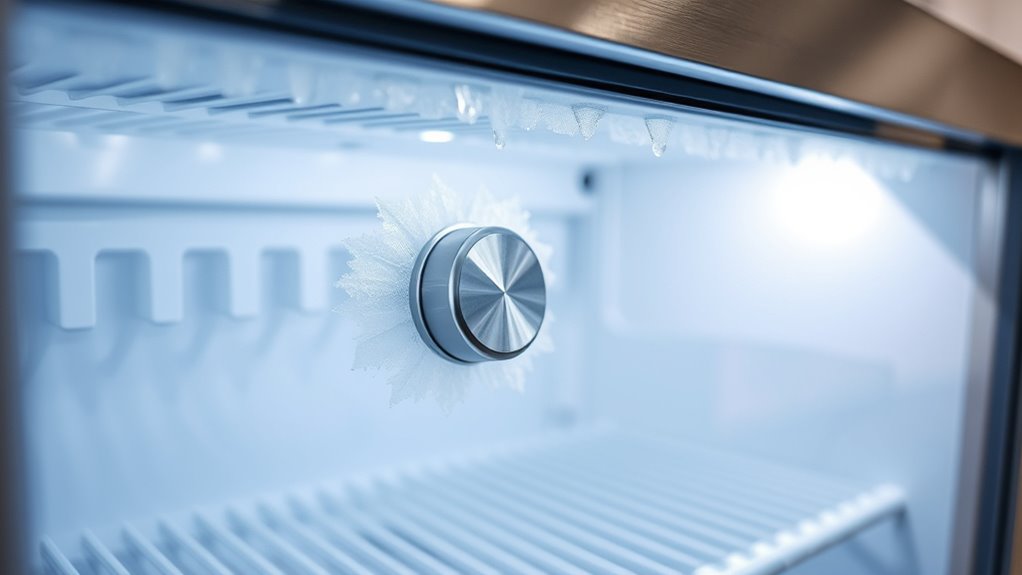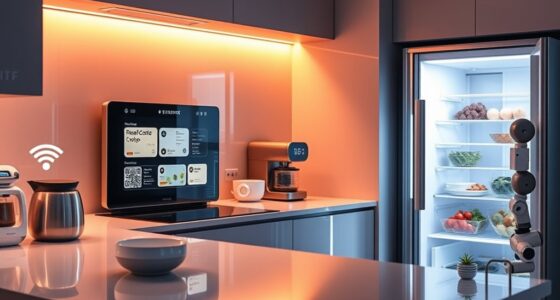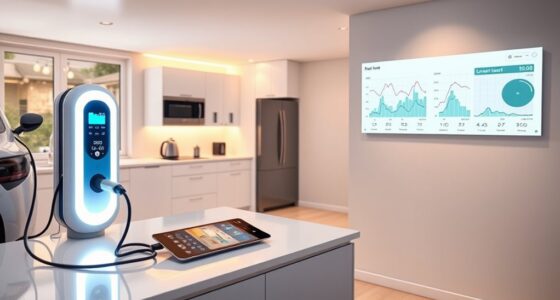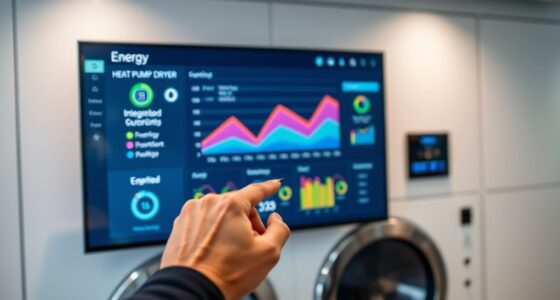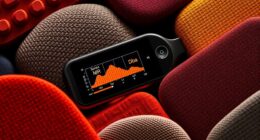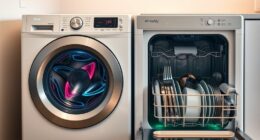Automating defrost cycles with sensors helps you improve energy efficiency by accurately detecting ice buildup and temperature changes. Instead of relying on fixed timers or manual checks, sensors monitor conditions continuously, triggering defrosts only when needed. This reduces energy consumption, prevents frost-related damage, and lowers maintenance costs. Implementing this smart approach means less manual oversight and better system reliability. If you keep exploring, you’ll uncover how to choose the right sensors and optimize your system further.
Key Takeaways
- Sensors detect ice buildup and temperature changes to trigger defrost cycles only when necessary, optimizing energy use.
- Temperature, humidity, and infrared sensors continuously monitor system conditions for accurate, real-time defrost control.
- Automated defrost systems reduce manual intervention, lowering labor costs and preventing ice accumulation-related system issues.
- Early detection of compressor problems via sensors enhances maintenance planning and prevents costly failures.
- Implementing sensor-driven defrosting improves efficiency, extends equipment lifespan, and can reduce energy consumption by up to 20%.
The Limitations of Traditional Defrosting Methods

Traditional defrosting methods often rely on fixed timers or manual intervention, which can be inefficient and unreliable. You might find that the system defrosts too early, wasting energy, or too late, risking ice buildup. Manual defrosting requires constant monitoring, which is time-consuming and prone to human error. Fixed timers don’t account for variations in usage or environmental conditions, leading to inconsistent results. As a result, appliances can operate inefficiently, increasing energy costs and reducing lifespan. These methods also cause inconvenience, as you have to remember when to defrost or reset timers. Overall, traditional approaches lack flexibility and precision, making them less suitable for modern needs where efficiency and automation are priorities. Incorporating sensor-based control systems can address these limitations by dynamically adjusting defrost cycles based on real-time conditions, ensuring optimal performance and energy savings. Additionally, integrating AI-driven technologies can further enhance the responsiveness and accuracy of defrost cycles, a development that aligns with the ongoing trend of AI Security and intelligent automation in various sectors.
How Sensors Detect Ice Buildup and Temperature Changes

Sensors used in modern defrost systems actively monitor ice buildup and temperature changes to determine when defrosting is needed. They detect ice accumulation by measuring electrical resistance or changes in thermal conductivity, which increase as ice forms. Temperature sensors keep track of the coil’s heat levels, signaling when temperatures drop below ideal ranges. These sensors continuously send data to the control system, enabling real-time evaluation. Incorporating advanced fabric decorating markers can also enhance maintenance and customization options for these systems. Key detection methods include: – Resistance measurement of the evaporator surface – Thermal conductivity sensors detecting ice-layer changes – Infrared sensors measuring surface temperature – Ultrasonic sensors assessing ice thickness – Thermistors monitoring coil temperature. Additionally, regular calibration of sensors is essential to maintain detection accuracy over time, ensuring the system responds appropriately to changing conditions. Using sensor diagnostics tools can help identify and resolve issues promptly, maintaining optimal system performance. As technology advances, integrating smart sensor networks can further improve system responsiveness and reliability. For example, implementing predictive maintenance algorithms allows for early detection of sensor failures, minimizing downtime. Together, these sensors provide accurate, timely information, automating defrost cycles and improving efficiency.
Types of Sensors Used in Automated Defrost Systems
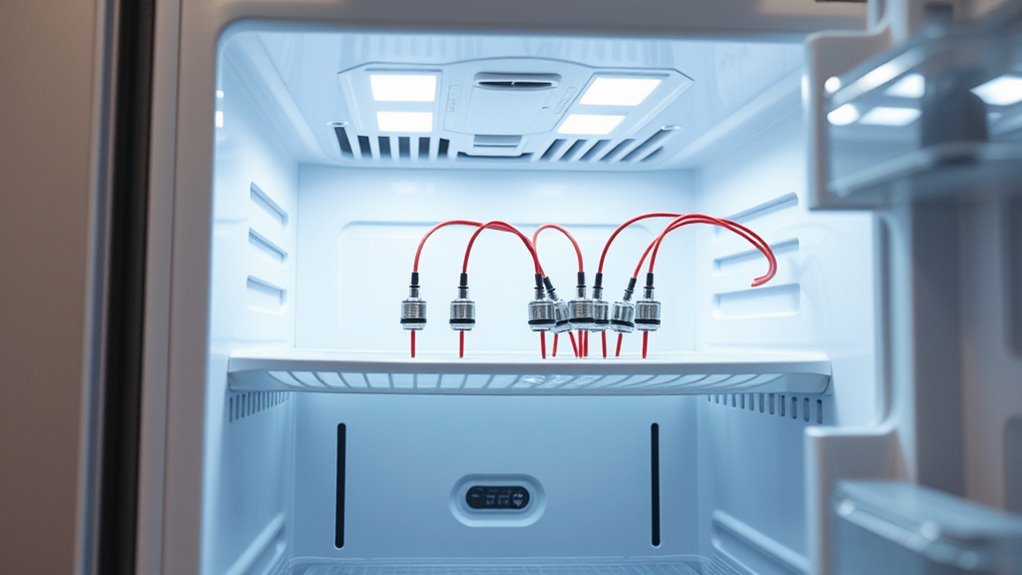
Automated defrost systems utilize a variety of sensor types to accurately detect ice buildup and temperature changes. Temperature sensors, like thermistors and thermocouples, monitor cold areas and trigger defrost cycles when temperatures drop below set points. Humidity sensors help identify moisture levels that indicate ice formation, especially in humid environments. Infrared sensors detect ice by measuring surface heat differences, providing quick responses without contact. Capacitive sensors measure dielectric changes caused by ice accumulation on surfaces, offering precise detection. Additionally, resistance sensors measure changes in electrical resistance caused by ice buildup. Each sensor type has unique advantages, and selecting the right combination depends on your system’s design and environment. Proper sensor choice guarantees efficient, reliable defrosting and maintains ideal appliance performance, especially when considering the importance of indoor air quality in system operation. Understanding sensor calibration is essential to ensure accurate detection and prevent unnecessary defrost cycles, ultimately improving energy efficiency and system longevity. To optimize detection accuracy, regular maintenance and testing of sensors are recommended to account for environmental changes and sensor drift. Incorporating advanced sensor technologies can further enhance system responsiveness and reliability. Furthermore, integrating smart sensor systems can enable real-time monitoring and adaptive control for improved efficiency.
Benefits of Sensor-Driven Defrost Cycles for Efficiency and Cost Savings

Using sensors to trigger defrost cycles offers significant advantages in improving energy efficiency and reducing operational costs. By precisely timing defrosts based on actual conditions, you avoid unnecessary energy use and prevent frost buildup that hampers performance. This targeted approach minimizes downtime and extends equipment lifespan. The benefits include:
Sensor-triggered defrosting enhances efficiency, reduces costs, and extends equipment lifespan through targeted, condition-based operation.
- Reduced energy consumption through optimized defrost timing
- Lower utility bills thanks to increased efficiency
- Decreased wear and tear on components, reducing maintenance costs
- Fewer manual interventions, saving labor time
- Improved appliance performance and longevity
- Incorporating sensor technology can further enhance system responsiveness and reliability, ensuring consistent operation even under varying conditions. Additionally, leveraging smart control systems can optimize overall system performance and adaptability.
Implementing sensor-driven defrost cycles ensures your system operates only when needed, making your refrigeration more sustainable and cost-effective. These advantages lead to consistent savings and enhanced reliability over time.
Implementing Sensor-Based Automation in Existing Refrigeration Units

Integrating sensor-based automation into existing refrigeration units can substantially enhance their efficiency without the need for complete system overhauls. You can retrofit sensors to monitor temperature, humidity, or defrost cycles, enabling smarter control. This approach minimizes downtime and reduces installation costs. To help visualize, consider this table:
| Sensor Type | Key Benefit |
|---|---|
| Temperature Sensors | Precise defrost triggering |
| Humidity Sensors | Prevents excess frost buildup |
| Vibration Sensors | Detects compressor issues early |
Frequently Asked Questions
How Do Sensor Calibration Issues Affect Defrost Cycle Accuracy?
When sensors aren’t properly calibrated, it can throw off the accuracy of defrost cycles. You might find that defrosting happens too often or not enough, leading to inefficiencies or equipment issues. Miscalibrated sensors send incorrect temperature readings, causing the system to trigger defrosts at the wrong times. To guarantee peak performance, you need to regularly check and calibrate sensors, so they provide accurate data for precise defrost cycle control.
Can Sensor-Based Systems Adapt to Different Refrigeration Environments?
You can rely on sensor-based systems to adapt to different refrigeration environments, provided they are properly calibrated. These systems detect temperature and humidity changes, adjusting defrost cycles accordingly. Regular calibration guarantees accuracy across varying conditions. When set up correctly, sensors learn and respond to environment shifts, optimizing energy use and preventing frost buildup. So, with proper calibration and maintenance, sensor-based systems effectively adapt to diverse refrigeration settings.
What Are the Maintenance Requirements for Sensor-Driven Defrost Systems?
When maintaining sensor-driven defrost systems, you need to regularly check sensor accuracy and clean them to prevent dust or ice buildup. Test the system periodically to guarantee it activates correctly and monitor for any error messages or malfunctions. Replace sensors as needed and keep software updates current if applicable. Proper maintenance helps keep your refrigeration running efficiently and extends the lifespan of your sensor system.
Are There Safety Concerns With Automated Defrost Sensor Installations?
You might wonder if installing automated defrost sensors poses safety risks. Generally, these systems are designed with safety features, but improper installation or maintenance can lead to electrical hazards or sensor malfunctions. Always guarantee professional installation and regular inspections. Keep sensors away from water or moisture to prevent short circuits. By following manufacturer guidelines and safety protocols, you can minimize risks and enjoy reliable, efficient defrost operation.
How Do Sensor Failures Impact Overall Refrigeration Performance?
If your sensors fail, it’s like your entire refrigeration system hits a catastrophic pause button. Without proper sensor signals, your fridge might frost over like a winter wonderland or, worse, run nonstop, wasting energy and risking food spoilage. You could face endless defrost cycles or none at all, turning your perfect fridge into a chaotic, ice-covered disaster zone. That’s why sensor reliability is vital for smooth, efficient cooling.
Conclusion
By switching to sensor-driven defrost cycles, you open a future where your refrigeration runs smoother and more efficiently than ever before. Say goodbye to endless manual defrosting and wasted energy—your system will detect ice buildup before it causes costly damage. Embrace this technology now, and you’ll revolutionize your operation, saving money and avoiding disaster. Don’t let outdated methods hold you back—step into the future of refrigeration today!
